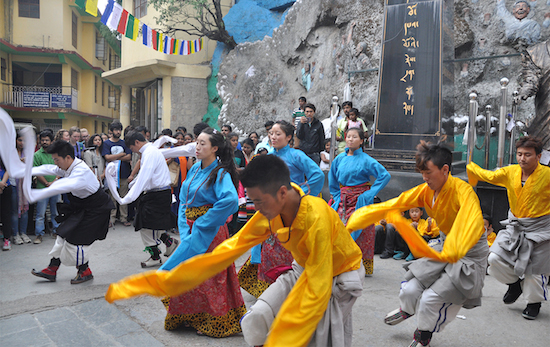Thousands Participate in the Tibet Museum’s Three-Day International Museum Day from May 18 – 20, 2016

From left: DIIR Secretary Mr Tashi Phuntsok, Sikyong Dr Lobsang Sangay, DIIR Secretary Mr Sonam Norbu Dagpo and Director of Tibet Museum Mr Tashi Phuntsok at the release of Tibet Museum’s new exhibition catalog, 18 May 2016
The Tibet Museum of the Department of Information and International Relations (DIIR) joined 35,000 museums in 145 countries to celebrate the 39th annual International Museum Day from May 18 – 20, 2016.
The three-day programme consisted of a series of events, including: guided tours of the permanent exhibition, “A Long Look Homeward”; a talk and lecture series on Tibet history, culture and the current situation inside Tibet; live thangka paintings and displays; a showcase of costumes from the three provinces of Tibet; documentary screenings; and cultural performances by school children.
The inauguration ceremony was attended by chief guest Sikyong Dr. Lobsang Sangay, the two secretaries of the DIIR, Mr. Sonam Norbu Dagpo and Mr. Tashi Phuntsok, along with representatives from Tibetan non-governmental organisations and heads of Tibetan schools based in Dharamshala.
The event began with a lighting of the Tibetan butter lamp by Sikyong Dr. Lobsang Sangay. Mr. Tashi Phuntsok, Director of the Tibet Museum, welcomed the guest and highlighted the Tibet Museum’s role in addressing Tibet issues, as well as the importance of organising international events at the Tibet Museum. He also called on the Tibetan public and tourists to visit the museum as often as they could to expand their knowledge of the Tibet issue and further the Tibetan political narrative.
This was followed by two releases – Sikyong Dr. Lobsang Sangay released the Tibet Museum’s exhibition catalogue, “A Long Look Homeward,” and DIIR Secretary for International Relations, Mr. Sonam Norbu Dagpo, launched the Tibet Museum’s promotional video.
Mr. Tashi Phuntsok, Information Secretary of the DIIR, addressed the gathering and said that, “since the inception of the Tibet Museum in 1998, it has become a repository of information, which conveys the story of Tibet’s history, culture, religion and the plight of Tibetans under Chinese rule. Its collections have been collated in an institutionalized and scientific way.”
Sikyong Dr. Lobsang Sangay lauded the Tibet Museum’s relentless hard work in raising awareness on the Tibet issue. He also stated that museums remain one of the most powerful mediums to preserve the rich cultural heritage of Tibet and further political narrative on the Tibetan struggle. He called on Tibetans, particularly those still in schools and colleges, to visit the Tibet Museum to gain a deeper insight into the Tibetan political struggle and life of Tibetans in exile.
“It is important for students to visit the Tibet Museum because we are mostly in the third or fourth generation of Tibetan refugees. Our generations have not faced the hardships of our forefathers. The struggles of the older generation are preserved only in our memories and school textbooks. Therefore, it is imperative for us to visit The Tibet Museum to transform that imaginary struggle into reality,” Sikyong said.
Later in the afternoon, three documentaries on Tibet issues were screened and our guest speaker, Ms. Penghsuan Lee, spoke on the topic, “Tibet and Taiwan – Challenges and Opportunities.”
On the second day (May 19th), Mr. Sonam N. Dagpo gave a talk entitled “Introduction to Middle-Way Approach,” and Mr. Karma Chungtak spoke on “Education and Learning,” offered exclusively in the Tibetan language. A documentary movie, “Arts in Exile, Leaving Fear Behind,” and “History of Tibet” were screened.
On the concluding day (May 20th), Ms. Kalden Tsomo, head of the UN and EU desks of the DIIR, spoke on the “Current Human Rights Situation in Tibet,” and Mr. Tashi Phuntsok, Information Secretary of the DIIR, gave a presentation entitled “Introduction of CTA.” Documentary films on Tibet: “Stranger in My Native Land,” “Tibetan Eldorado (Brown Gold of Tibet)” and “Undercover in Tibet,” were also screened. The closing address was given by Mr. Sonam N. Dagpo, DIIR Secretary for International Relations, and the event concluded with a traditional Tibetan dance and Gorshey (Circle Dance) in vibrant traditional dress performed by students of the Mewon Petoen School and Sherab Gatsel Lobling.
The festival was a resounding success. More than 4,500 people visited the Tibet Museum during the three-day event, including many first-time visitors.

Sikyong Dr Lobsang Sangay with a group of Tibetan school children in traditional Tibetan costumes

DIIR Secretaries Mr Sonam Norbu Dagpo and Mr Tashi Phuntsok at the concluding session of Tibet Museum’s three-day event, 20 May 2016

Students of Sherab Gatsel Lobling performing a traditional Tibetan dance, 20 May 2016

School children from Mewoen Petoen school presenting a Tibetan group song, 20 May 2016
